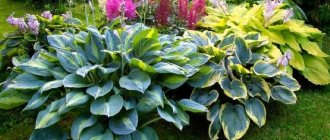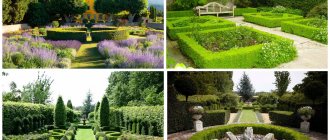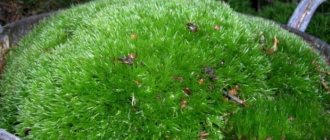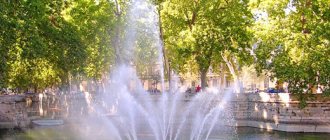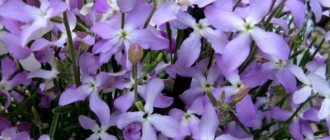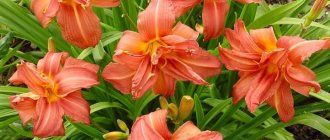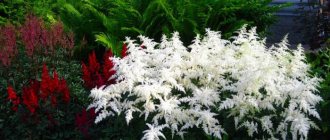All gardeners and owners of country plots try to create beautiful places for relaxation and recreation. It is impossible to imagine a single flower bed without bright, interesting flowers or bushes. If flower arrangements or flower beds are not for you, then you should pay attention to tapeworm plants in landscape design. Properly selected crops will become an excellent accent in the design of the site, making it unusual and thoughtful. We invite you to familiarize yourself with the characteristics of such plants and their use in the garden.
What is Solitaire in landscape design
Tapeworms (Solitarius) is the name that is used for separately located shrubs, trees, and flower crops. Specimens are planted as an accent on a background open area or an array formed from other plantings.
The use of tapeworms is popular both in summer cottages and in the arrangement of park areas. The advantage of using this technique is that when viewing it from afar, you can see the created form as a whole, and when you get closer, you can study the details from all sides. Heading along Solitaire, you will be able to get closer to it, but move away, all the time, changing the point of focus. Such plants in the area create garden dynamics and add compositional rhythm.
Let's look at the main types of compositions
Tapeworm.
Used for the most beautiful shrubs that can attract everyone's attention even when planted alone. For example: hydrangea, euonymus, derain, viburnum, weigela, barberry and others.
Groups.
There are simple and mixed. A simple group combines plants of only one species, while mixed ones can contain two or more different shrubs and trees. Moreover, both deciduous and coniferous crops.
Hedges. Free-growing plants are located around the perimeter of the garden, forming a kind of walls and barriers. This composition takes up a lot of space, but captivates with its spectacular flowering and picturesque appearance.
Mixborders. In this composition, shrubs create a background for perennial plants. All plants match each other in size, flowering period and color palette. Sometimes for mixborders they choose only one dominant shrub. For example, an evergreen rhododendron will decorate your composition in the spring with its lush blooms, while the perennials in the foreground wake up and take on a decorative appearance. And later it will serve as a charming background for them until freezing.
Let's take a closer look at the subtleties of the landscape using mixborders as an example.
Is color important in landscape design?
When working with color, it is possible to increase the space of the garden using some techniques. Objects located at a distance from the viewer appear lighter and blurrier. This is called "Aerial Perspective" and can be advantageously applied to the backyard.
As you move away from the object, warm orange and yellow colors fade out first, then cool shades of orange and red, and blue is the last color to disappear in the atmospheric haze, so mountainous areas and forest areas on the horizon appear blue.
The rich yellow shades of the leaves visually bring the composition closer to the observer, while the gray shades create the effect of distance. Green and purple are neutral. By following this order, you can visually increase the scale of the garden.
How to choose the right tapeworms to decorate your garden
The main rule when choosing is to give preference to those crops that are proportionally suitable for the area and house of the site. The height of the crop should be in proportion 1:3 to the width of the territory.
In miniature areas, it is quite difficult to comply with this rule, so it is better to give preference to low-growing plantings, trimmed topiary forms, weeping types of trees and bushes. A good option for small areas would be to plant fruit crops. By wisely combining cherries, cherries, and apple trees, you will be able to create a beautiful area and get a harvest of fresh fruits.
Mighty tree species, for example, Oaks and Birches, are also used in park plantings. Gardeners also recommend leaving old plantings on the site, because with proper redevelopment, they will become excellent tapeworms.
The plants that look most organically in landscape design are tapeworms that have a geometrically correct crown configuration (spherical or pyramidal). It will be a big plus if the bushes can withstand shaping haircuts.
The use of bonsai is considered a modern trend. Such plantings will suit not only the Chinese or Japanese style, but will also act as an excellent tapeworm.
Plants for solo planting
As a rule, trees or shrubs, as well as perennial herbaceous plants, are chosen for single planting. In this case, the tapeworm must have a number of distinctive qualities:
- the plant must be tall;
- holds its shape well (resistance to drooping)
- give in to the formation of the trunk and crown;
- be equally beautiful from all angles;
- have high decorative qualities that do not lose relevance at any time of the year.
Conifers
Among the plant “soloists”, it is first of all worth highlighting the representatives of the coniferous group. Their external characteristics do not depend on seasonality; coniferous plants are easy to care for and take root well in almost any conditions. Therefore, representatives of evergreen plants are always popular.
The most traditional species in this group can be called spruce. These lush beauties add a touch of nobility and tranquility to almost any area.
Larches are rarely found in garden plots due to their great height, but if you choose the right variety and shape the crown, they will become an original addition to any garden or patio.
Juniper and fir will delight gardeners not only with their beauty, but also with the beneficial properties of the fruit.
It is impossible not to mention the thuja, which has long been a favorite of landscape designers, on par with boxwood, allowing you to create dizzying geometric shapes.
Deciduous trees
Birch is a real Russian beauty, giving the areas a calm and cozy look.
If you want your lawn to be reminiscent of warm days spent on the Cote d'Azur, decorate it with bamboo.
If you have large areas, take a closer look at beech; this tree has always been valued for its nobility and the creation of a calm atmosphere.
Willow - the value of this plant, especially the weeping species, is revealed over time.
In addition, the lush crowns of chestnuts and linden trees look charming.
Beautiful flowering shrubs
Euonymus - valued for its unusual inflorescences and unique foliage color.
Barberry - during flowering it is simply impossible not to notice this bush, but when planted alone it is demanding in terms of care and formation.
Erica - during flowering, this shrub is completely covered with densely packed inflorescences.
Bobovnik has beautiful yellow inflorescences, but one of the disadvantages is that it is too large in size, given that planting this beauty requires large areas.
But buddleia can be used even on miniature lawns, where lush clusters of a small bush will help create an unusual landscape.
Hydrangea is another stunning plant that can make an area fabulously beautiful.
Serviceberry, cotoneaster, snowberry and almond - each of these plants has high decorative qualities not only during flowering, but also during fruiting. The list can be supplemented with mountain ash, lilac, ornamental apple tree, Japanese plum and others.
Herbaceous plants
Ptilothus is one of the most popular perennials, suitable for small group plantings. Swamp iris, Rogersia, and some varieties of delphinium also look great in single plantings. Hosta will look great in shaded areas.
Classics of the genre - roses or rose hips.
In general, among plants you can find quite a lot of species that will look good in a solo planting. And their choice depends only on what result you want to get.
Video “Choosing a tapeworm plant”
Popular foliage tapeworm plants in the garden
To create a harmonious garden design, it is not necessary to choose intricate and exotic crop options. Even the most ordinary plants will become a wonderful central figure if they are played wisely.
Among deciduous crops, it is better to give preference to species that have non-standard branches and an original crown shape.
The most popular options are:
- Japanese or Canadian maples (as well as other varieties). They are distinguished by their original spherical crown and large leaves, which in the fall acquire a golden-burgundy hue.
- Decorative apple trees or “Russian sakura”. These are trees that bloom with beautiful pink flowers that are semi-double or double.
- Weeping willows. They are distinguished by drooping branches and are found in both large and small areas, since there are also dwarf varieties of the tree.
- Jacquemman's birch trees. The peculiarity of such a tree is that after 6 years its bark acquires a snow-white hue.
- Tibetan cherries (serrate). It is characterized by the curvature of the branches, the bark has refined transverse strokes, and the shoots are usually burgundy in color.
Shrubs are usually planted in front of lawns - lilac, hydrangea, mock orange, spirea, weigela are suitable.
The best candidates for the role of tapeworm
In the nomination “Best Leaf Tapeworm” we see the largest number of worthy contenders:
Red-leaved cherry plum
or
Pissardi plum
. Looks impressive against the backdrop of a lawn and coniferous trees. In spring it bears a cloud of dark pink flowers, followed by purple leaves and red fruits. The color of the crown remains bright even in drought. The green chlorophyll of the leaves is “masked” by carotenoids and anthocyanins. The former are considered one of the best antioxidants, which explains the resistance of red-leaved plants to temperature changes and diseases.
Catalpa bignoniiformes, Catalpa beautiful
. Trees with a rounded crown and unusually large leaves. The inflorescences resemble white “candles” of horse chestnut. The long, tube-shaped fruits last all winter. Catalpa looks like a true exotic, grows slowly and does not take up much space.
Maple
(false sycamore, Canadian or sugar, other types). A popular decorative deciduous tree is valued for its beautiful crown, usually spherical or wide-conical in shape. Large leaves in the fall delight with gold and crimson. Japanese, Shirasawa, palmate or fan maples look especially impressive. These are bushes or trees in purple, red, maroon and orange colors.
Red leaf peach
. It is difficult not to notice the dark purple crown of this decorative form of the famous fruit plant. Small fruits are hidden between the oblong leaves. This is the case when the desire to admire beauty outweighs the desire to taste the harvest.
Decorative apple tree
. The low tree exported from Japan is called “Russian sakura”. In spring, the oval or spherical crown is completely covered with light or dark pink buds; in summer, small fruits ripen (in most varieties they are inedible). Forms with semi-double and double flowers have been developed.
Excellent material for creating a tapeworm:
- cultivars of English oak, sessile and other species with a neat crown;
- tomentose linden, small- and large-leaved;
- white, purple, weeping willow;
- horse chestnut, etc.
Each of the above breeds has its own advantages, and ultimately, the landscape designer decides which one to choose. In our online store PLANTLAND.RU, seedlings of most of these trees are available for sale, and in addition, many of them can be purchased as large trees, or you can order targeted growing in a nursery to certain dimensions, with subsequent delivery and planting in a permanent place.
Coniferous trees and shrubs as tapeworm
Among the coniferous crops, the most popular among landscape designers are:
- blue spruce, both low and tall are suitable;
- Junipers, dwarf thujas;
- common pines.
In addition to their beautiful appearance, conifers also enrich the air with a beneficial aroma.
Tall perennial flowers and cereals are also often used as tapeworms. Irises, Phloxes, Roses, Rogersias, Daylilies, and Lilies cope well with this task.
Solitaires
Just as a diamond needs a good setting, a solitaire needs a decent background. For example, a neatly trimmed green lawn. Or the edge around the plants, mulched with peat, tree bark or wood chips: it gives solitary plantings special clarity.
When placing single plants, it should be taken into account that the distance from the point of perception to the plant itself should be equal to two to three times its height. With a greater distance, it is impossible to see the individual decorative elements of this plant, and with a decrease in the required distance, the effect of its size decreases; it seems to hang over the viewer.
A plant suitable for the role of a tapeworm must not only be large enough and very beautiful (with unusual leaves, spectacular flowers and berries, an original shape of a bush or crown). It should not lose its decorative effect during spring, summer and autumn. It would be great if this plant can remain spectacular in winter. And besides, it will retain its qualities for many years.
Where is the best place to plant tapeworms in the garden?
When choosing a place to plant, rely on your own taste preferences. But there are still several important rules that are best adhered to when planting:
- It is better to plant tall trees away from the house or fence, so that when they reach large sizes, they do not cause trouble to neighbors or block sunlight;
- Solitaire plants in landscape design with dark leaves look appropriate next to a gazebo, benches, and paths;
- representatives with large, bright leaves or flower crops will organically fit into the composition next to a plain fence or outbuildings;
- It is better to plant crops that prefer a lot of light in sunny areas, and place crops in shady areas in light partial shade.
If desired, you can decorate the composed rock gardens or rockeries with solo planting. Short or medium-sized representatives are suitable for this.
Features of a single landing
How to plant a tapeworm so that it brings joy and does not bring problems to the owner of the site? This question can perhaps be called one of the most important. Since tapeworms are usually perennial plants or large trees, you need to plan their stay in the garden or near the house very carefully:
- When choosing moisture-loving plants for planting, do not replace them near the foundations of houses or other buildings. Excessive watering can destroy the cement. It is best to place such flowers near bodies of water.
- The same goes for tall trees. As the root system grows, it can damage the foundation of the house or bend paths, so it is better to move their planting deeper into the garden.
- Do not plant conifers close to windows. Their main advantage - the evergreen crown can become the main disadvantage, shading rooms in both summer and winter. Placing deciduous varieties will be much more effective. In summer they will bring coolness, and in winter they will let in more light.
- When planting a tree as a tapeworm, imagine how it will look in winter. It may be worth giving preference to dwarf or decorative varieties, in which you can form not only a crown, but also give fancy bends to the trunk.
- When choosing a plant, take into account its lighting preferences. Some ornamental species cannot withstand constant direct sunlight, while others will not reach their potential in the shade.
- Make sure that the plant you choose can grow without garters and can withstand wintering in an open place.
- When choosing abundantly flowering and deciduous forms, keep in mind that sooner or later, all the beauty will fly around and shower the space around it.
- If you are planning to create an unusual gazebo, take a closer look at willow or trees with a spreading crown.
- When planting tapeworms along fences and fences, calculate the degree of growth. Over time, plants increase not only in height, but also in width.
Secrets of harmonious arrangement and planting of tapeworms
When planting crops, take into account the agrotechnical characteristics of each representative. Remember about the correct soil and location. It is also important to take into account the secrets of a harmonious arrangement of crops on the territory. For example, often to emphasize an accent plant, not one, but several are used, and they are located next to each other.
As a solo specimen, often plant flowers in pots or cache-pots. For example, gorgeous roses will look very elegant when planted in containers.
Duets created on the basis of single plants located next to entrance areas, a fountain, and a barbecue look harmonious. When planting solo representatives in a row, it will be possible to form a sophisticated alley.
Experiment, choose beautiful crops, then tapeworm plants in landscape design will create an incredible effect of lightness and harmony. A decorated area near the house will bring only positive emotions.
Which plants to choose for salting on the lawn
Now we come to the most important thing - choosing decorations for the lawn. Let me remind you that the plants should not be very low (the only exception is tapeworms for small lawns), so that the bright beauty can be appreciated at a great distance from the planted specimen. Usually tapeworms are placed so that the plant can be viewed from all sides, but in small garden plots the tapeworm can be planted so that the plant can be viewed from only three sides.
Typically, the following plants are used for tapeworm plantings:
- Coniferous or deciduous trees - you can argue that it is more interesting to plant evergreen conifers, but some deciduous trees are very impressive in winter due to their structured crown or multi-colored bark, which is very noticeable against the snow.
- Fruit trees - they are indescribably beautiful during spring flowering and fruiting. Of particular charm are columnar crops, which do not have to be grown in open ground; they can be planted in a container and used as a lawn decoration only during the highest degree of decorativeness.
- Shrub - it can be either decorative deciduous or green. Often, for solitaire plantings, crops with elegant flowers or those varieties that can be shaped by pruning are chosen.
- Herbs - tall perennial herbs perfectly suit the purpose of being a tapeworm; we will talk about the range of these plants in more detail below.
- Tall flowers - the range of these crops is increasing with each passing year; among the huge number of flowers, it is even difficult to choose the best, but we will try.
As part of this article, I want to introduce you to unusual tapeworms that have not yet become widespread, so I will not review the varieties of trees and shrubs, I will only talk about fruit crops, herbs and flowers.

